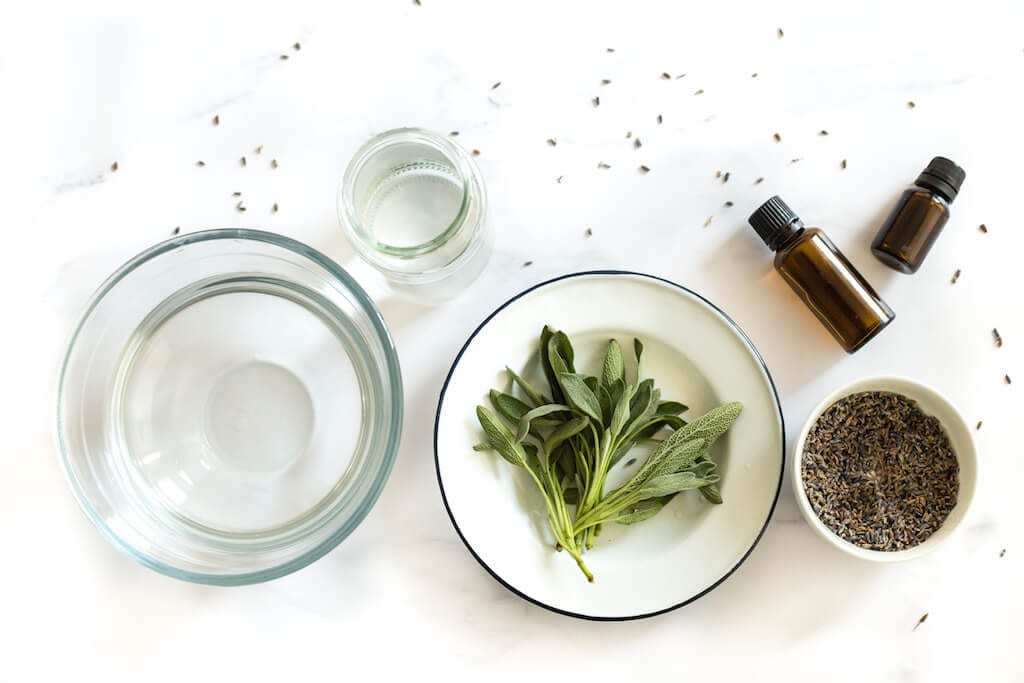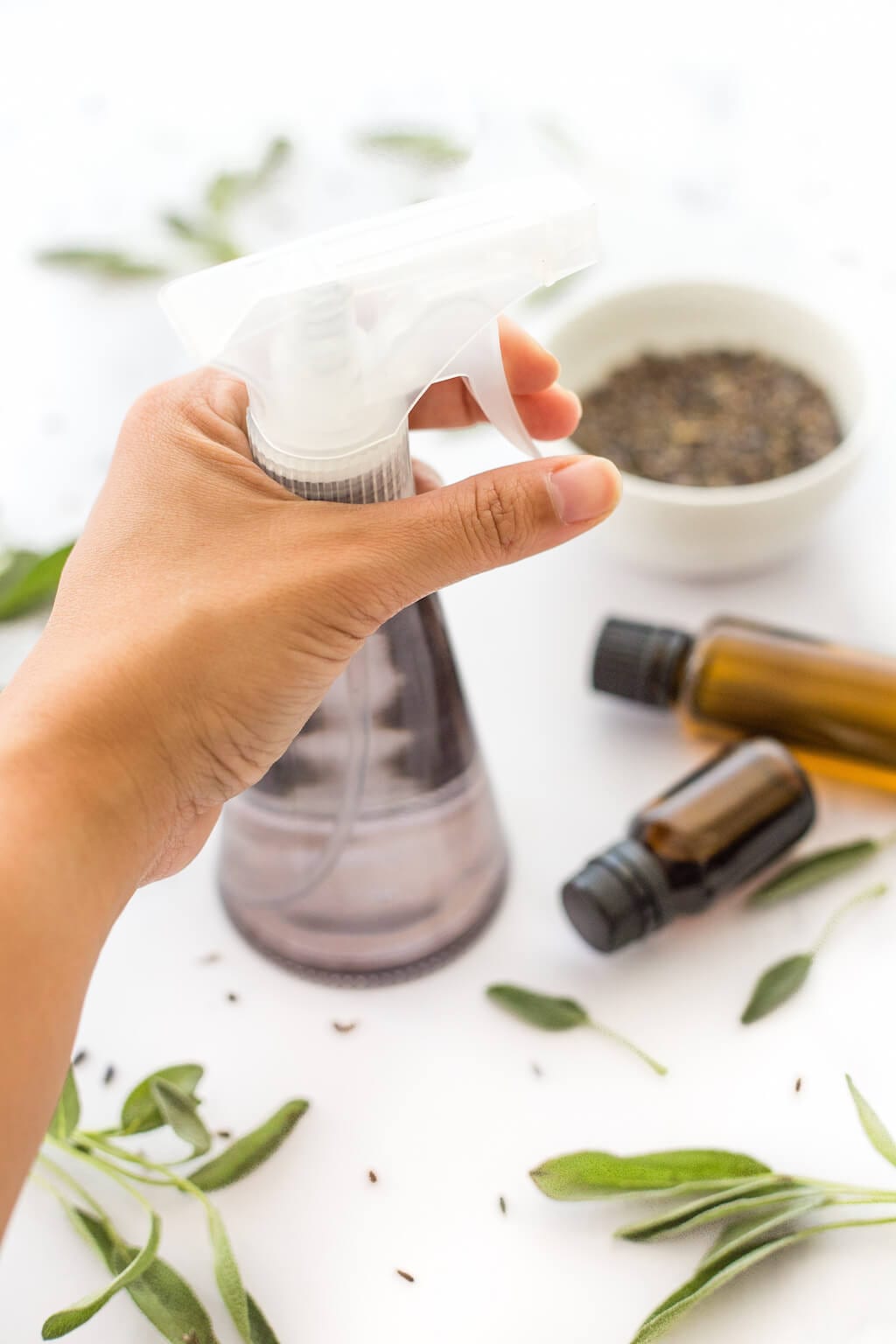
If you’re finding it difficult to get your hands on store bought hand sanitizer right now, don’t fret. Here’s how you can make your own natural hand sanitizer with just a few basic ingredients.
Below, I include recipes for both a hand sanitizer with 60% ethanol and 70% ethanol.
For the first recipe, you’ll just need: ethanol, unscented witch hazel, and essential oils. The ethanol has strong antiviral effects and is recommended by the CDC. Witch hazel is a plant with many medicinal properties, and of the many different species of witch hazel, the one most commonly used for medicine is the Hamamelis virginiana. Its leaves and bark are used for making tea ointments.
The health benefits of witch hazel include its ability to help reduce inflammation and reduce skin irritation. Studies have also found that witch hazel helps in fighting off certain viral infections, which is why we use it to complement the ethanol in this hand sanitizer recipe.
For the second recipe, this will require a few more ingredients. The reason being this sanitizer has ethanol in the 70% ratio, which the CDC considers to be ideal for viruses. The glycerine added helps offset the drying effect of the ethanol, and the xanthan gum prevents natural separation of the ingredients.
What is Ethanol?
Ethanol (also called ethyl alcohol, alcohol, Methylcarbinol, or grain alcohol) is the name for the chemical formula CH3CH2OH or C2H6O
It’s essentially the scientific name for pure alcohol. Purified alcohol contains less than 1% water. Ethanol is a primary ingredient in alcoholic beverages like wine and beer. When we talk about alcohol content in alcoholic beverages (5% in beer, 12.5% in wine, etc), we’re talking about ethanol content. Pure alcohol is considered 200 proof in the USA and Canada.
Ethanol is also antibacterial, so it’s often used as a topical disinfectant, including in hand- or other sanitizing products. However, it’s important to note that the minimum application time until it’s able to properly disinfect is 25 to 30 seconds.
Ethanol, Isopropyl Alcohol, and Rubbing alcohol – What is The Difference?
Isopropyl alcohol (2-propanol or isopropanol) has a different formula than ethanol: C3H8O. It is often found in rubbing alcohol as the main ingredient. The percentage will be stated on the front of the bottle: often “70% isopropyl alcohol.”
You can buy Isopropyl alcohol, which is general considered to be more powerful than rubbing alcohol because it is more concentrated. It generally comes in 50%, 70%, 91%, 99% concentrations. A 95% ethyl alcohol or ethanol is also available.
Rubbing alcohol is a term that includes both isopropyl alcohol (isopropanol) and ethyl alcohol (ethanol) containing products. So, the difference between these three products (ethanol, isopropyl alcohol, and rubbing alcohol) is that rubbing alcohol contains either ethanol or isopropyl alcohol. Also, a product may simply be called isopropyl alcohol while noting its dilution rate.
Rubbing alcohol, as it is denatured, may include additional ingredients besides water and alcohol, such as acetone or other additives that are used in the denaturing process. Undenatured is the pure form and may also be listed as “food grade.”
Is It Safe to Use on My Skin?
Ethanol is safe to use on the skin. However, it tends to be drying and may be irritating. More dilution is better to help avoid irritation. On the other hand, it might be better to opt for the isopropyl alcohol instead, since isopropyl alcohol isn’t as likely to dehydrate living tissue like skin.
Another thing to keep in mind is that ethanol has been found to be a “penetration enhancer” for other compounds. For that reason, it’s important to consider what other ingredients are in your hand sanitizer, since the ethanol can help them to penetrate the skin and get into the bloodstream.
Keep Ratios in Mind
The reason we use 95%+ pure ethanol for that portion of the recipe is that it needs to be as close to 100% as possible and not pre-diluted. That’s because once we dilute it in the recipe, we want a ratio of 7 parts ethanol to 3 parts other ingredients to arrive at a final product that is 70% alcohol.
Reminder: Nothing Beats Washing Your Hands
Hand sanitizer should be a last resort – If there’s no soap and clean water around, use it. However, it won’t work as well as washing your hands, which is one of the best ways of protecting yourself from germs and viruses.
Helpful Tips for Making Your Own Hand Sanitizer
- The main rule of thumb is to use 60% of ethanol to 40% witch hazel for you sanitizer to be affective. Use ethanol with a concentration of 95% or higher. I recommend this brand here. Then you’re free to play around with the essential oils with the scents you find most appealing.
- Feel free to swap out the lavender and sage essential oil combination for other combinations such as lemon and rosemary, and orange and mint in equal quantities.
- To avoid contaminating your recipe, make sure to disinfect any tools you’re using.
- The WHO recommends letting your solution sit for 72 hours before use. This lets the sanitizer kill any existing germs in the bottle or alcohol.
How to Use Hand Sanitizer
Spray the hand sanitizer into the palm of one hand and rub over the entire surface of your hands, fingers, and wrists. Do this for at least 60 seconds (the amount of time it takes to kill most germs) or until your hands are dry.
- 1 ½ cups ethanol (99% or highest you can find - at least 95%)
- 1 cup unscented alcohol-based witch hazel
- 5 drops lavender essential oil, optional
- 5 drops sage essential oil, optional
- Combine the ethanol, witch hazel, and the essential oils (optional) in a mixing bowl. Mix well to combine.
- Transfer to spray bottle.
- Let stand 72 hours (as recommended by the WHO) before using for maximum strength.
Tip: You can swap witch hazel with aloe vera (this will make the sanitizer less drying and more moisturizing) at a 3:1 ratio. However, note that aloe vera goes bad quickly (without the use of harsh chemicals), in about 3-4 days, so this might not be the most practical option.

- 1¾ cup ethanol (95% or the highest you can find)
- ¾ cup vegetable glycerine
- Pinch of xanthan gum
- 10 drops total, essential oils (a single oil or a combination of: lemon, sage, rosemary, lavender, or thyme)
- Combine the ethanol, glycerine, xanthan gum, and essential oils in a mixing bowl. Mix well to combine.
- Transfer to the bottle.
- Let stand 72 hours before use.
PS: If you’re looking for a ready-made hand sanitizer you can take on the go, try our non-toxic hand cleaner here. It contains 70% alcohol which is in compliance with C.D.C.’s requirement for a hand sanitizer to be effective in killing the current novel virus, as well as bacteria. Of course, all our ingredients are safe and don’t have the hormone-disrupting and cancer-causing chemicals found in many market-leading brands.

Resources
National Library of Medicine. Ethanol | CH3CH2OH. PubChem website. Accessed April 21, 2020.
Mathew, F., & Goyal, A. Ethanol. StatPearls [Internet]. January 2020. [Updated 2020 Apr 8].
Lachenmeier, D. W. Safety evaluation of topical applications of ethanol on the skin and inside the oral cavity. Journal of Occupational Medicine and Toxicology. November 13, 2008.
Journal Online staff. Ethyl or isopropyl alcohol? | Journal Online. People’s Journal. February 21, 2020.
Is ethanol rubbing alcohol or do i need to order it??
I was thinking the same thing…. rubbing alcohol, ethyl alcohol, ethanol????? Here’s a link that should help clarify the terms.
https://www.thoughtco.com/alcohol-versus-ethanol-3976082
So we can use vinager ias an option to Ephanol ?
What percentage should be in the alcohol?
Hi Pam,
Your end product should be 60% alcohol (or more), per the CDC’s most recent recommendations. Their are many ways in which you can accomplish this.
One of the ways we suggested for you to create your own hand sanitizer is by simply mixing an ethanol that is 95% alcohol, with a witch hazel (which are typically 14% alcohol).
I personally created my own hand sanitizer by combining 1 1/2 cups of 190 proof Everclear and 1 cup of Humphreys Organic Witch Hazel, 5 drops of lavender essential oil, and 5 drops of sage essential oil.
Healthy Regards,
HB team
DO NOT USE VINEGAR because vinegar does not do anything against coronavirus. Vinegar kills 88% of GERMS. The virus is not a germ. It has to do with the virus makeup which is protein and lipids (fats). That’s why washing hands thoroughly for full 20 seconds in warm (doesn’t have to be hot) water is so effective. 91% (Isopropyl) to 99% ethanol alcohol (everclear) is.effective because it removes oils and the virus from the skin.. Vinegar does not. The deal with alcohol is that it evaporates quickly which is why a thickener like glycerin is used so it says on the skin for at least 20 seconds. BTW find a link to see if you are washing hands properly and putting ln hand sanitizer properly.
Thank you Diana for clarifying. Clarinda, current information from CDC suggests hand santizers should have 60% ethanol. Our recipe calls for 60% of ethanol to 40% witch hazel for your sanitizer to be affective. If you use ethanol with a concentration of 95% or higher. Then you’re free to play around with the essential oils with the scents you find most appealing.
Please explain what is ethanol and how to buy it. On Google it is always denatured, which might mean poison added so it can’t be ingested. Is this safe to use?
If it is high proof grain alcohol from the liquor store, in California the maximum proof allowable is 120, or 60%. So it cannot be diluted to make good hands sanitizer. Thank you.
Hi Laa,
I may be incorrect, but I believe you can purchase 151 proof in California which translates out to 75.5% alcohol.
You just want to be sure that your end product is 60% alcohol or more.
If you decide that you cannot, or do not want to make your own hand sanitizer, we will be offering our own brand of hand cleanser for sale shortly. This cleanser complies with all hand sanitizer requirements from health authorities.
Healthy regards,
HB Team
What is the difference between ethanol and isopropyl alcohol. I attempted to search for it on Amazon with no luck, Do you have a link to the sources your use for that AND the alcohol-based witch hazel? Thanks so much,
Pam
I personally created my own hand sanitizer by combining 1 1/2 cups of 190 proof Everclear (95% alcohol) and 1 cup of Humphreys Organic Witch Hazel (14% alcohol), 5 drops of lavender essential oil, and 5 drops of sage essential oil.
Healthy Regards,
HB Team
Thank you for the information but I am still a bit confused…. in your recipe you state to use at least 95% Ethanol – which actually becomes a 60% or 70% alcohol after water is added to it??
Also the link provided for the recommended Ethanol to use takes me to an Isopropyl Alcohol?? Aren’t these two different products?
Thanks for any help!
Hi Cindy,
The important point is to make sure your end product is at least 60% alcohol per the CDC’s recommendation. This is why our recipe suggests using something with at least 95% alcohol content. You can find this in many different forms, including 190 proof grain alcohol (drinking) or in a high alcoholic content isopropyl alcohol (both will work).
Healthy Regards,
HB Team